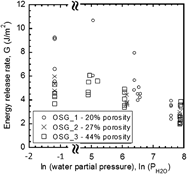Article contents
The effects of low temperature and pressure on the fracture behaviors of organosilicate thin films
Published online by Cambridge University Press: 31 August 2011
Abstract

A novel load–displacement sensing instrument has been designed and fabricated to characterize the fracture properties of brittle thin films at low temperature (approximately −30 °C) and pressure (1.6e-4 Pa) environments. In this study, the instrument was used to investigate the effects of harsh environments on the fracture behaviors of organosilicate glass (OSG) and silicon carbonitride (SiCN) thin films under four-point bend loading. Experimental results showed that the fracture strengths of film stacks are the highest when the environment contains a very low water molecule concentration. This condition can be achieved by purging the testing chamber with pure nitrogen or reducing the chamber pressure to less than 1 Pa. In contrast, cracks propagated readily along OSG/SiCN interfaces when experiments were performed in deionized water. The effects of low temperature (approximately −30 °C) and pressure on thin film fracture were also studied, and the results demonstrated that there is no observed degradation of the OSG fracture properties. X-ray photoelectron spectroscopy (XPS) technique was used to identify the chemical composition of the fracture surfaces.
Keywords
Information
- Type
- Articles
- Information
- Copyright
- Copyright © Materials Research Society 2011
References
REFERENCES
- 4
- Cited by

